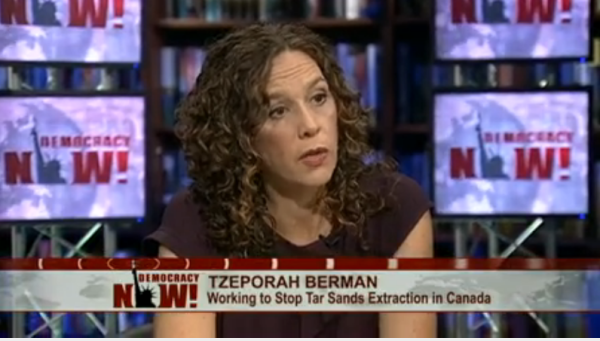Five years ago this month, the firm TransCanada submitted a permit request to build the Keystone XL oil pipeline, which would bring tar sands oil from Canada to refineries on the Gulf Coast. The project has sparked one of the nation’s most contentious environmental battles in decades. The Obama administration initially appeared ready to approve Keystone XL, but an unprecedented wave of activism from environmentalists and residents of the states along its path has forced several delays. Among those pressuring Obama for Keystone XL’s approval is the Canadian government, which recently offered a greater pledge of reduced carbon emissions if the pipeline is built. We’re joined by one of Canada’s leading environmental activists, Tzeporah Berman, who has campaigned for two decades around clean energy, and is the former co-director of Greenpeace International’s Climate Unit. She is now focused on stopping tar sands extraction as a member of the steering committee for the Tar Sands Solutions Network. Berman is also the co-founder of ForestEthics and is the author of the book “This Crazy Time: Living Our Environmental Challenge.” Berman discusses how the Canadian government is muzzling scientists speaking out on global warming, quickly changing environmental laws, and why she believes the push for tar sands extraction has created a “perfect storm” of grassroots activism bring together environmentalists, indigenous communities and rural landowners.
GUEST:
Transcript
“This is a rush transcript. Copy may not be in its final form”.
AMY GOODMAN: Five years ago this month, the firm TransCanada submitted a permit request to build the Keystone XL oil pipeline, which would bring tar Sands oil from Canada to refineries on the Gulf Coast. The project has sparked one of the nation’s most contentious environmental battles in decades. The Obama administration initially appeared ready to approve Keystone XL, but an unprecedented wave of activism from environmentalists and residents of the states along its path has forced several delays. In the summer 2011, 1200 people were arrested outside the White House. Well, on Saturday, protests were held once again around the country in a national day of action urging President Obama to reject Keystone’s construction. President Obama also faces continued pressure from backers of the Keystone XL. In their latest push for the project, House Republicans have announced plans to tie the pipeline’s construction to the upcoming vote on raising the nation’s debt ceiling. Well, on Monday, delegates at the 2013 International Women’s Earth and Climate Summit held in Sufferin, New York called on Obama to reject the Keystone XL, saying, “There is no single project in North America that is more significant than Keystone XL in terms of the carbon emissions it would unleash… As women who are already seeing the tragic impacts of climate change on families on indigenous peoples, and on entire countries, we urge you to choose a better future by rejecting the Keystone XL tar sands pipeline.” At the conference, Melina Laboucan-Massimo, a member of the Lubicon Cree First Nation, described the impact that massive oil and gas extraction has had on her family and its traditional land in northern Alberta.
MELINA LABOUCAN-MASSIMO: I come from a small northern community, it’s Cree, Nēhiyaw, is, in our language, what we call it. There is nothing on — that compares with the destruction going on there. If there were a global prize for unsustainable development, the tar sands would be a clear winner. Not that there’s a competition going on or by any means, but, I just think that world-renowned people, experts are really seeing this as one of the major issues and that is why it is one of the biggest — you know, the largest sources of greenhouse gas emissions in Canada and why Canada pulled out of the Kyoto Protocol.
So, this is what it looks like. very viscous. It’s, you know, not fluid, so it takes a lot more energy a lot more water, produces a lot more byproduct. So, it’s equaling to — why it is such a big area, it’s 141,000 square kilometers — equal to that of destroying, you know, England and Wales combined, or the state of Florida for American folks. The mines that we’re dealing with are bigger than entire cities. So, there’s about six, seven right now, could be up to nine. And this is — Imperial Oil, for example, will be bigger than Washington, D.C. alone. So, that’s just a mine. And this is some of the biggest dump trucks in the world. A lot of the issues of toxicity we’re talking from the air, so these are some of the biggest dump trucks in the world. And a lot of the issues for toxicity that we’re dealing with is, and which relates to the water, are these huge tailing ponds; they’re called ponds, but they’re actually big toxic sludge lakes. They currently spend 180 square kilometers just of toxic sludge that’s sitting on the landscape. So, every day one million leaders are leaching into the Athabasca Watershed, which is, you know, where our families drink from. I’m from the Peace Region, but it connects to the Athabasca and it goes up into the Arctic Basin, so that is where all the Northern folks will be getting these toxins, and these contain cyanide, mercury, lead, polyaromatic hydrocarbin nythetic acids. So, there are a lot of issues that we’re dealing with healthwise.










